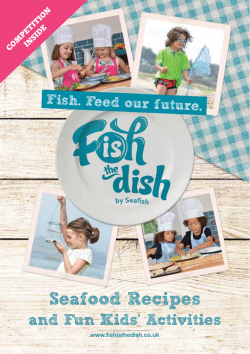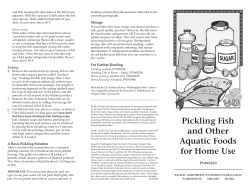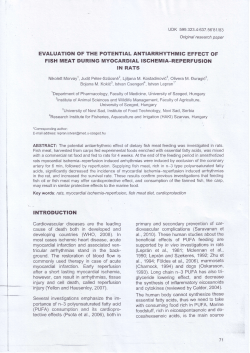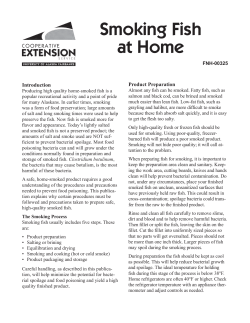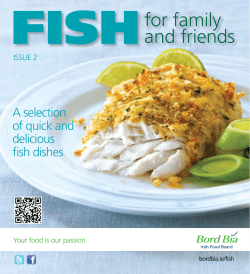
FREE Your guide to selecting, purchasing and preparing the highest quality Lake
FREE Your guide to selecting, purchasing and preparing the highest quality Lake Superior fish Introduction Gichigami (Lake Superior) is the greatest of the Great Lakes. In 1834 the American Fur Company began a fish processing enterprise at La Pointe (Madeline Island) and shipped four to five thousand barrels of fish that year on the John Jacob Astor, a 111- ton schooner, and other sailing vessels. Lake Superior is so large it could hold the water from all the other Great Lakes, along with three more Lake Eries. With an average depth approaching 500 feet, its cold, clear waters produce many fish with high levels of natural omega 3 oil. The Lake Superior fishing tradition: Prior to European contact, Ojibwe tribal fishermen used large birchbark canoes and gill nets constructed from twisted and knotted strands of willow bark to harvest fish from Lake Superior. As Europeans entered the Great Lakes region, the Ojibwe used fish to trade with French and English outposts. Fish soon became one of the mainstays in the diets of the early fur traders. Some of the earliest visitors enjoying Lake Superior whitefish, lake trout, and lake herring included Etienne Brule (1620) and Pierre-Esprit Radisson and Médard Groseilliers (1654). Lake Superior’s cold, clear waters supply fish to area fish shops which specialize in fresh boneless filets, “fresh” frozen vacuum packaged fish, hand smoked delicacies, gourmet smoked fish spreads, and fish pickled using great-grandma’s recipe. “the whitefish is most esteemed for the richness and delicacy of its flavour, and there is a universal acquiescence in the opinion formerly advanced by Charlevoix, ‘that whether fresh or salted, nothing of the fish kind can excel it’” Henry Schoolcraft 1820 1 Lake Superior fish fresh from the big lake to your plate. To get the freshest Lake Superior fish contact one of the many fish shops located along Lake Superior’s south shore. WISCONSIN Apostle Island Fish Company, LLC 37400 North Bradum Road Bayfield, WI 54814 715-209-3916 (Cell), 715-779-0193 apostle_island_fish_comp@hotmail.com Peterson’s Fisheries Shawn Hansen 2 Miles North of Bayfield on Hwy 13 Shop 715-779-5023, Home 715-779-5727 Newago Fish Market Alan & Cathy Newago 707 Old Military Road, Bayfield, WI 54814 Shop 715-779-2388 Newago Fisheries Dave Newago, Sr. P.O. Box 193, Odanah, WI 54861 715-682-3902 2 MICHIGAN Keweenaw Bay Fisheries Brad and Dale Dakota 1 mile South of L’Anse on Hwy 41 906-524-6767 Peterson’s Fish Market Gil & Pat Peterson 49813 Us Highway 41 Hancock, MI 49930 906-482-2343 Wilcox Fishery Ralph & Shirley Wilcox 1232 S Wilcox Lane Brimley, MI 49715 906-437-5407 Parrish Fisheries Bob Parrish 11108 W Lakeshore Drive, Brimley, MI 49715 906-248-5764 3 Selecting and purchasing the best Lake Superior fish Selecting high quality fish is the first step in ensuring consumer satisfaction and maintaining quality control in your restaurant. Purchasing whole Lake Superior fish INSPECT eyes YES - make the purchase NO - reject the fish bright, clear, bulging eyes cloudy, sunken, discolored or slime-covered eyes skin translucent mucus that looks like varnish sticky, yellowish brown mucus color vivid and bright discolored flesh firm and elastic flesh separating from the rib cage bones when dressed (i.e. gutted) cavity clean and fully eviscerated blood and entrails in cavity smell cucumber smell strong fish or ammonia smell indicates spoilage Purchasing fresh Lake Superior fish filets INSPECT YES - make the purchase NO - reject the fish bones pin-boned (all bones in the filet are removed) pin-bones not removed - customers will encounter fish bones during their dining experience flesh moist, firm and elastic flesh with a transparent sheen dried out or gaping (the muscle fibers are beginning to pull apart) skin translucent mucus that looks like varnish sticky, yellowish brown mucus smell cucumber smell strong fish or ammonia smell indicates spoilage 4 Purchasing Lake Superior frozen fish filets INSPECT YES - make the purchase NO - reject the fish visual packaging clear plastic to enable buyers to examine filets for signs of drying, freezer burn, frost or ice crystals packaging that prevents visual inspection of frozen filets freezing & storage quickly frozen to prevent formation of ice crystals and solidly frozen frost, ice crystals, or not solidly frozen freezer burn tight vacuum packaging to prevent freezer burn, fat oxidation, or cross-contamination freezer burn caused by moisture loss during frozen storage can be seen on the filet processing date on label frozen fish is turned over on a first-in, first-out basis (fish used within 3 months of being vacuum packed tastes like fresh fish if properly handled) no lot number/processing date, or filets have been frozen for over 9 months (i.e. the maximum freezer storage time) Quality clues from fish displays INSPECT YES - make the purchase NO - reject the fish temperature control thermometer present with a reading <38°F, fish filets displayed inside separate pans surrounded by ice, or filets in plastic bins in refrigerators no thermometer present or a temperature reading of >38°F, fish piled high, open display cases, fish siting under hot lights proper icing of whole fish whole fish displayed under ice to avoid flesh from drying whole fish not displayed under ice crosscontamination smoked fish is stored in a separate refrigerator or smoked fish stored above raw fish raw fish stored above smoked fish appearance clean environment to control bacteria lack of cleaning and fish odors This information is reprinted from Food Safety NEWS published by Michigan State University, Cooperative Extension Service. Spring 1992.) 5 Proper handling of Lake Superior fish Receiving fish deliveries at your restaurant Adequate refrigeration is essential in maintaining high quality standards for all Lake Superior fish products including smoked fish, salted fish, marinated fish, and fresh fish. It is essential the fresh fish delivered to your restaurant is well refrigerated or held at as near the temperature of melting ice as possible at all times. Check the fish delivered to your restaurant with a thermometer to ensure your staff maintains the restaurant’s quality control standards. It is important to properly ice fish as soon as it is purchased from the fisherman by making a 1 to 2 inch bed of crushed ice, layering ice with fish, and topping the cooler off with 2 to 3 inches of It is equally important to inspect frozen fish filets for signs of drying, freezer burn, frost or ice crystals. Ensure filets have tight vacuum packaging to prevent fat oxidation and crosscontamination. Also check labeling to make sure filets delivered to your restaurant have not been frozen for over 9 months and ideally less than 3 months. additional ice. Icing fish provides the benefits of 1) rapidly cooling the fish; 2) slowing bacteria growth and enzyme activity; 3) flushing away bacteria as the ice melts; 4) preventing drying; 5) improving texture by delaying rigor mortis in hot weather; and 6) improving texture by resisting freezing in cold weather. Food scientists have conducted studies on bacterial growth that support the recommendation that fish be iced regardless of weather conditions. Their studies have also determined that the flushing action of melting ice extended the shelf life of fish in coolers by controlling bacterial growth. Handling and transporting dressed fish for summer grilling Customers can purchase dressed (i.e. gutted and gilled) Lake Superior fish directly from commercial fishing vessels or fish shops. It is important to follow a couple of simple rules to ensure the Lake Superior fish you purchased for your summer grilling is properly handled and transported. Upon returning home, rinse the whole fish in clean water and wipe the cavity clean to make sure all blood and entrails are removed and the fish is ready for seasoning and grilling. Start by cleaning your cooler with hot water and detergent, rinse the cooler with clean water, sanitize the cooler with bleach, and again rinse the cooler with clean water - this will help to control bacteria and improve the taste of your fish. (The information summarized in this article is based upon Michigan State University Cooperative Extension Service’s Commercial Fish Handling and Sanitation on Great Lakes Vessels, Extension Bulletin E-1324.) 6 Handling and storing fresh filets in your restaurant It is commonly recommended to cook fresh fish within two days of purchase. It is equally important to properly store the fish until the time you cook it. Never let your Lake Superior fish sit unrefrigerated for long, especially in a hot car. If necessary, transport your Lake Superior fish home in an ice chest or ask your fish market to pack it in ice for you. Handling frozen filets in your restaurant There’s nothing wrong with frozen fish that’s been thawed, but if you unknowingly refreeze it, its texture and flavor will suffer. In fact, recent taste tests conducted by Michigan State University’s Food Science Laboratory concluded that frozen vacuum packed whitefish was preferred over fresh fish. Handle your fish with care. Lake Superior whitefish is particularly delicate and its flesh bruises easily. This bruising releases enzymes which attract bacteria. This causes whitefish to spoil more rapidly. Improper thawing of frozen fish can quickly destroy high quality fish products. Thawing the fish partially or completely before cooking is necessary when other preparatory steps such as stuffing a dressed fish, separating fillets for skinning or breading, marinating fillets, and cutting fish into pieces for chowders or stews are involved. To improve quality, schedule thawing so that the fish will be cooked soon after it is thawed. For best results in flavor and texture, do not hold thawed fish longer than a day before cooking. Always thaw vacuum packed fish under refrigeration to prevent botulism. As soon as possible refrigerate your Lake Superior fish as close to 32 degrees as possible. Fish can be held twice as long at 32 degrees as it can be at 37 degrees. To store fresh fish, remove it from its package, rinse under cold water and pat dry with paper towels. When fish sits in its own juices, the flesh deteriorates more rapidly. To prevent this, place cleaned whole fish or filets onto a cake rack so that the fish filets do not overlap. Set the rack in a shallow tub or pan. Cover the tub or pan with plastic wrap or foil, seal tightly and refrigerate. Each day, drain all fluids, rinse fish under cold water, clean the rack and the pan and change the ice. If the fish has a fishy or ammonia smell after being rinsed, it should be discarded. It is recommended that the following steps be undertaken when thawing Lake Superior fish: • 7 Place vacuum packed fish in the refrigerator for 18 to 24 hours for 1 lb package. • When requiring more rapid thawing, remove the filet from the package and thaw under continuously flowing cold water that is maintained at a temperature of 60°F or below. • In the microwave oven, wrap fish loosely in waxed paper or place in covered dish or leave in unopened package. Thaw on LOW or DEFROST for 15 to 30 seconds on Medium-low 30% power or defrost. minutes. botulism bacteria. These spores grow and produce a toxin when non-acid food (e.g., meat, fish, poultry, and vegetables) is held in an airtight container such as a plastic bag or cans. Botulism is both deadly and hard to detect since it produces little noticeable evidence of spoilage. Because botulism produces heat-resistant spores and requires the absence of oxygen for growth, it has been commonly associated with improperly canned food (usually home canning). While the botulism toxin can be deadly, it is easily controlled. Using Hazard Analysis Critical Control Point (HACCP) techniques, Lake Superior fish smokers ensure proper salt content in their brining solutions. Fish smokers also ensure adequate cooking times (i.e. a minimum of 30 minutes) and temperatures (i.e. a minimum of 145/F) to destroy the bacteria that produces the botulism toxins. Thawing at room temperature or by immersion in hot water are not recommended as these methods increase the amount of moisture loss. Thawed fish should not be refrozen before cooking because this will damage the flavor and texture. Handling smoked fish and smoked fish products Smoked Lake Superior fish has been enjoyed by visitors for hundreds of years. This regional delicacy remains available today at numerous locations along Lake Superior’s south shore. Smoked fish customers are often under the impression that smoked fish is “preserved” and does not need to be refrigerated. This is wrong and could be a deadly mistake. Lake Superior fish smokers also use HACCP techniques to ensure that smoked fish products are stored at proper temperatures (38/F or below) and are properly labeled. Customers reading the labels provided on smoked fish products will find these products must be: “ kept refrigerated at or below 38/F, and eaten by a specified expiration date.” Ensuring that your smoked fish is properly refrigerated will keep your customers safe and returning for more of Lake Superior’s famous smoked fish. Remembering a few important points will protect the health and safety of your customers when transporting and storing smoked fish. Clostridium botulinum, commonly referred to as botulism, is found in soil, water, vegetables, meats, dairy products, and fish. The botulism toxin develops from spores of the 8 Educating your customers health benefits of eating Lake Superior fish Æ Many Lake Superior fish species (i.e. lake trout, whitefish, herring, and chubs) provide significant sources of omega 3 fish oil. Lake Superior’s heart healthy fish Fish provide a low-fat, high protein source of food that is known to provide health benefits. What is not commonly known is that Lake Superior fish contain a high amounts of heart healthy omega 3 oils. Æ The primary benefit of omega 3 fish oil is the reduction of blood clotting and plaque formation which can prevent heart attacks. • “The primary benefit of N-3 fish oil is the reduction of platelet activity (blood clotting) and plaque formation which in turn can prevent heart attacks.” Æ The American Heart Association recommends that adults, except pregnant women, eat two servings of fish a week. • “Many Lake Superior fish species (i.e. lake trout, whitefish, herring, and chubs) provide significant sources of N-3 [omega 3] fish oil.” Æ Eating fish regularly reduced the risk of heart disease in diabetic women by as much as 64 percent, according to study reported in Circulation: Journal of the American Heart Association (04/01/2003) • “The omega-3 content of Lake Superior fish are higher than chinook salmon, which is one of the best saltwater sources of omega 3.” Fish Oil and Your Health and Omega-3 Fatty Acid Content of Lake Superior Fish, Dr. Paul B. Addis Æ Harvard researchers found eating broiled or baked fish one to three times a month was associated with a 14 % reduction in stroke risk and eating broiled or baked fish one to four times a week was associated with a 28 % reduction in stroke risk. Why your restaurant should offer your customers broiled, baked, or boiled Lake Superior whitefish. Æ Harvard researchers found consumption of fried fish or fish sandwiches was associated with a 37 % higher risk of all kinds of stroke. With an aging baby boomer population, it will be every more important to offer customers the options of baked, boiled, or broiled Lake Superior fish and note these items on your menu as heart healthy dinning alternatives. Æ Preliminary results, from Pennington Biomedical Research Institute (Louisiana State University in Baton Rouge), indicate omega-3 fatty acid .... found in fish oil may boost insulin function in people who are vulnerable to type 2 diabetes. 9 Door County Fish Boil Recipe Door County is located in the northeastern part of Wisconsin. Fish boils are a tradition in the area dating over a hundred years. Most fish boils are made with the Whitefish native to the area. Ingredients: • • • • • • 1 or 2 Whitefish cleaned, gutted and gilled. Chopped into steaks 2 inches thick, about 6 lbs 6 medium onions, peeled 6-10 carrots, peeled 10 medium red potatoes, scrub and poke several holes with a fork in each potato or slice a piece off each end 1 cup salt 2 sticks melted butter Instructions: Wash the Whitefish steaks with cold water. In a large kettle bring 6 quarts of water to a boil. Add the salt, potatoes and carrots. Cover the kettle and return to a boil, then add the Onions. Cook for 20 minutes. Add the Whitefish Steaks, cover and boil for 12 minutes more. When the fish is done it will flake easily. Do not over cook. Remove from heat and drain. Serve Whitefish, Potatoes, Onion and Carrot with the melted butter. Serves six. The traditional Door County Fish Boil always serves Cherry Pie as dessert. Used with permission from Frank Juzwik, Lake Michigan Angler, www.LakeMichiganAngler.com Whole Grilled Whitefish Ingredients: • • • • • 1 whole Whitefish (approx. 1.5 lbs), dressed and de-scaled 1 medium onion, sliced 1 lemon, sliced Salt and pepper to taste Canola oil, as needed Instructions: Wash whitefish in cold water, then pat dry. Sprinkle cavity with salt and pepper, then line the cavity with sliced onion and lemon. Rub outer skin of whitefish with canola oil. Wrap fish in aluminum foil and seal completely. Grill 10 minutes per inch thickness (measured at its thickest part) and turn fish over halfway through the grilling time. (This means if the fish is 3 inches thick at its thickest part, grill for a total time of 30 minutes.) You would therefore grill 15 minutes on one side, 15 minutes on the other. 10 Grilled Whitefish with Dill Tartar Sauce Ingredients: • 1/3 cup mayonnaise type salad dressing • 1 Tbs. sweet pickle relish • 1 tsp. dill weed, or 1 Tbs., fresh, chopped • 1/4 cup unsalted butter, melted • 1 tsp. lemon juice • 4 whitefish fillets, or haddock or orange roughy fillets, about 6 ounces each Instructions: Prepare grill (medium heat). Combine first 3 ingredients in a bowl and mix well. Set aside. Combine butter and lemon juice in a separate bowl. Mix well. Arrange fish on grill and brush with butter mixture. Grill fish 5 inches from heat source 6-8 minutes, or until fish flakes with a fork, turning once and brushing occasionally with butter mixture. Serve with sauce. Prep: 5 min, Cook: 10 min. Orange Grilled Whitefish Ingredients: • • • • • • 1 pound Lake Superior whitefish fillet 1/2 cup Italian dressing 1/4 cup water 2 tablespoon orange juice 1 tablespoon Worcestershire sauce 1/2 teaspoon ground ginger Instructions: Cut fish into serving-size pieces and lay in a shallow acid proof dish. Combine marinade ingredients and pour mixture over the fish. Cover and let stand to marinate about 1 hr, turning once. Remove fish from marinade and place on oiled broiler pan. Broil 4 inches from heat source for about 4 to 6 minutes, or until fish flakes easily. Or grill on the grill. The left over marinade can be used in part to brush on the fish as it's cooking and the remainder can be heated and thickened with a pinch of corn starch and served as a sauce at the table. Garnish the platter with orange slices and serve. http://www.grilling-recipes.com/seafood/r1592.htm 11 Blackened Lake Trout Filets Ingredients: • • • • • • • • • • • 4-8 ounce Lake trout fillets 1 lemon, quartered olive oil 1 tsp salt 1 tsp cayenne pepper 1 tsp black pepper 1 tsp white pepper 1/2 tsp garlic powder 1/2 tsp onion powder 1/2 tsp thyme 1/2 tsp oregano Instructions: Take trout fillets and rub lemon wedges on both sides of the fish. Spray both sides of the fish with the non stick cooking spray. Mix seasonings together on a plate, and lay fillets in the seasoning mixture. Make sure fillets are well coated. On a outdoor grill, heat a cast iron griddle to high temperature for 15 minutes. Place fillets in griddle and cook 3 minutes each side. Zesty Baked Whitefish Filets Ingredients: • 4-5 lbs skinless whitefish fillets • 3 large onions - sliced • Peppers (1 red, 1 green, 1 yellow) -- sliced • 1 cup zesty Italian dressing • 1 cup sundried tomato dressing • Feta cheese (to personal preference) Instructions: Grease the bottom of a large glass pan and layer two-thirds of the sliced onions (separated into onion rings). Place whitefish fillets on top of the onion rings. Mix 1 cup of Italian dressing with 1 cup of sundried tomato dressing (blend with a whisk), then pour mixture over the fresh fillets. Top with the remaining third of the sliced onions and sliced peppers. Cover the dish and bake for 25 minutes at 350/F. (Uncover for the last 10-15 minutes). Serve sprinkled with feta cheese over rice or with baked potatoes and salad. 12 Sesame Broiled Whitefish Ingredients: • 2 Tbs. unsalted butter, melted • • • • 1/2 tsp. lemon juice 2 whole whitefish 3 Tbs. sesame seeds 1/2 lemon, cut in wedges Instructions: Turn broiler on. Combine melted butter with lemon juice in a measuring cup. Rub fish, inside and out with salt to taste and butter-lemon juice mixture. Broil 5 inches from heat source 5 minutes, basting once or twice. Turn and broil 4 minutes. Brush with butter, and sprinkle with sesame seeds. Broil 1-2 minutes. Prep: 5 min, Cook: 10 min., Serves 4 Whitefish or Lake Herring Chowder Ingredients: • 2 tbsp. finely diced ham • 1 bunch green onions, chopped • 3 medium potatoes, peeled & diced • 1 tsp. salt • 1/8 tsp. white pepper • 1 cup water • 1 quart milk, scalded • 1 lb. Minced whitefish or Lake Herring, thawed • 4 tbsp. soft butter • 4 tbsp. flour • 1 cup cream • paprika for garnish Instructions: In large heavy pot, sauté ham and onions together over medium heat until onions are soft. Add potatoes, salt, pepper and water. Simmer until potatoes are cooked. Add milk and minced whitefish. Stir to break up fish. In small bowl blend butter and flour until roux is formed. Stir mixture into chowder and cook until thickens. Add cream, don't boil. Garnish with paprika. Serves 6 National Fisheries Institute - www.nfi.org 13 Broiled Trout Filets with Herbs, Parmesan Cheese and Cream Lemon Wine Sauce Cream Lemon Wine Sauce • • • • • • • 3/4 cup dry white wine 1 T. freshly squeezed lemon juice 2 tsp. minced shallots 2 T. cream 1/4 cup unsalted butter, sliced for faster melting Salt and white pepper to taste 1/2 tsp. grated lemon peel Instructions: Combine whine, lemon juice and shallots in saucepan. Reduce over high heat until 23 teaspoons of liquid remain. Add cream, reduce for 30 seconds more. Add butter whisking constantly until butter is incorporated into the sauce. Remove from heat and strain into bowl. Whisk in salt, white pepper and lemon peel. Store in a small thermos to keep warm. Trout Fillets • • • • • • • • • 2-1/2 lb. Brook, Rainbow, Splake or Lake Trout fillets 4 T. melted butter Salt and freshly ground pepper to taste 3 tsp. fresh basil, minced 1-1/2 lb. fresh parsley, minced 1-1/2 lb. fresh chives, minced Dry white wine 6 small tomatoes sliced into julienne strips 4-6 oz. freshly grated Parmesan cheese Instructions: Preheat oven to 450F. Prepare cookie sheet with nonstick coating. Lay trout fillets in pan skin side down; brush with butter and season with salt and pepper. Sprinkle basil, parsley and chives evenly over fillets. Add white wine to prevent sticking. Bake for 4 minutes or until fish is done. Spread julienne tomatoes evenly over fillets and sprinkle with Parmesan cheese. Return to oven for 4 minutes to to finish cooking and melt the cheese. Serve with Cream Lemon Wine Sauce poured around fillets. 14 Smoked Whitefish or Smoked Lake Herring Stew Ingredients: • 1 tablespoon olive oil • 1 cup chopped onion • 1/2 cup chopped green pepper • 1/2 cup chopped carrot • 1/2 cup chopped celery • 1 teaspoon minced garlic • 1 can (14.5 oz) diced tomatoes • 1 can (15.6 oz) vegetable broth • 1 can (6 oz) tomato paste • 1/4 teaspoon sugar • 8 oz hot-smoked whitefish or herring, chunked • 1/4 cup dry sherry • Hot pepper sauce Instructions: Heat olive oil in large saucepan over medium heat; stir in onion, green pepper, carrot, celery and garlic. Cook, stirring occasionally, until vegetables are tender. Stir in tomatoes, broth, tomato paste and sugar; reduce heat to low. Simmer about 10 minutes, or until flavours blend. Add smoked whitefish and sherry. Continue cooking until heated through. Season with hot pepper sauce and additional sherry, if desired. 4 main-dish servings SMOKED WHITEFISH SALAD Ingredients: • (1) 8 oz pkg Philadelphia Cream Cheese • 1/2 pound smoked whitefish • 2 Tablespoons green onions, finely chopped • 1 Tablespoon fresh dill, finely chopped • 18 Teaspoons freshly ground pepper Instructions: Mix all ingredients until well blended. Refrigerate. Serve with matzoh, crackers or bagels, etc. Source: Philadelphia Cream Cheese Box Produced by the Great Lakes Indian Fish and Wildlife Commission with funding from the DHHS. - Administration for Native Americans. 15
© Copyright 2025


